
Original Link: https://www.anandtech.com/show/5834/corsair-vengeance-c70-case-review-going-for-the-gamers
Corsair Vengeance C70 Case Review: Going for the Gamers
by Dustin Sklavos on May 17, 2012 5:45 PM EST- Posted in
- Corsair
- Cases/Cooling/PSUs
- mid-tower
Introducing the Corsair Vengeance C70
Corsair has had an excellent run as a case designer, showing growth with each new enclosure by adding some features, subtracting other ones, moving things around, and generally continuing to experiment. The Obsidian and Carbide lines in particular have shown healthy progress, but today Corsair launches a fourth line under their popular Vengeance gaming brand: the Vengeance C70.
While the exteriors of the Obsidian and to a lesser extent Carbide cases have all been fairly austere, the Vengeance C70's target is pretty clear: they're going after gamers. Thus far, products in the Vengeance market have generally been of high quality and haven't been particularly ostentatious, but the C70's external design is an unusual step for Corsair. Is the C70 as a whole part of Corsair's continued evolution as a case designer, or is this their first major misstep along the way?
 G.jpg)
For the first time since I've started reviewing Corsair's cases, I'll admit I experienced trepidation when I saw the press materials for the C70. Military green? Handles on the top? Industrial-style power and reset buttons? This wasn't the Corsair I knew, the company whose most ostentatious design so far was the Carbide 500R (or, arguably, the well-received Graphite 600T). Sure, the C70 is available in white and gunmetal gray (a personal favorite) as well, and the interior is vintage Corsair, but it still feels to me like an odd bird in their lineup. Before we get to the detailed analysis, we'll start with the regular specs table:
| Corsair Vengeance C70 Specifications | ||
| Motherboard Form Factor | Mini-ITX, Micro ATX, ATX | |
| Drive Bays | External | 3x 5.25” |
| Internal | 6x 3.5"/2.5" | |
| Cooling | Front | 2x 120mm intake fans behind drive cages; 2x 120mm fan mounts |
| Rear | 1x 120mm exhaust fan | |
| Top | 2x 120mm/140mm fan mounts | |
| Side | 2x 120mm/140mm fan mounts | |
| Bottom | 2x 120mm/140mm fan mounts | |
| Expansion Slots | 8 | |
| I/O Port | 2x USB 3.0, 1x Headphone, 1x Mic | |
| Power Supply Size | Standard ATX | |
| Clearances | HSF | 170 mm |
| PSU | 180 mm | |
| GPU | 12.5" / 320mm | |
| Weight | ??? | |
| Dimensions |
19.72" x 9.13" x 20.98" 501mm x 232mm x 533mm |
|
| Special Features |
USB 3.0 connectivity via internal header Toolless side panels Support for up to 11 fans Carrying handles Removable drive cages "Military Green" finish; also comes in "Gunmetal Black" and "Arctic White" |
|
| Price | MSRP $139 | |
On paper and without seeing the case, there's not a whole lot that stands out with the C70. The one area that looks unusual is the sheer number of fan mounts available. While testing the Vengeance C70, the enclosure that remained fresh in my mind was the Corsair Obsidian 550D, their case engineered for silence. In terms of expansion and cooling potential, the 550D isn't actually all that different from the C70; with the C70 you lose a 5.25" external bay but gain three fan mounts, which would be more impressive if the flexible 550D wasn't already capable of supporting eight. That owes to Corsair's positioning the C70 as a potential go-to for watercooling, with two different places to mount 240mm radiators. Indeed, all of their review materials present the C70 with Corsair's own H100 closed loop liquid cooler installed. We didn't have a watercooling kit for review, unfortunately, so we're looking at the C70 primarily as a typical desktop chassis.
In and Around the Corsair Vengeance C70
While I've generally appreciated Corsair's aesthetics (even the Vengeance branded keyboards have a nice, simplistic design to them), the Vengeance C70 enclosure threw me for a loop. I'm not sure when the military styling became popular, but the C70 looks like an awfully good place to store an ASUS Sabertooth (just like in the reviewer's guide!) or one of Gigabyte's G1 series boards. The "Military Green" finish is probably the most garish of the three; I suspect the "Gunmetal Black" is probably going to be the one everyone will want to shortlist, but I could be mistaken.
The front of the C70 boasts a trio of 5.25" bays, with the power, reset, and I/O occupying the space that ostensibly would've been a fourth. The stylistic choice is clean enough, but the power button has a distinct "this-belongs-inside-a-tank" look, and you actually have to flip up a tiny plastic door to access the reset button. It's a cute touch, but also practical, ensuring nobody ever accidentally hits the reset button. Beneath the drive bays is a honeycomb-style vent with a honeycombed grate pattern behind it (honeycomb is pretty much the pattern of choice across the C70), and there's room beneath the fascia for two 120mm fans.
 G.jpg)
When we move to the top of the case is when we see the oddest parts: the two 120mm/140mm fan mounts (and corresponding ventilation) are dead center of the top, flanked by the clamps for the side panels and the two carrying handles. Centering the fan mounts (and thus the internal mounts) is actually a smart move; if the end user wants to install a 240mm radiator, the radiator winds up being out of the way of the AUX12V line and some of the power circuitry. The only way this could be improved would be to shift its alignment closer to the left side panel as SilverStone did with the Temjin TJ04-E.
While the back of the C70 offers no surprises (eight expansion slots, a bottom-mounted PSU, and a couple of rubber-lined radiator holes), the left side panel features a large window with two vertically aligned 120mm/140mm fan mounts. Corsair offers rubber grommets for all of its case fan screws (and extras are included in the package) to prevent issues with fan vibration. Removing the side panel is accomplished similarly to opening a toolbox: flip the latches up on the side panel, then release the clamps. Panels hinge out from the bottom. The clamps are remarkably snug, leaving me with none of the reservations I had with the panel mounting system used on the 550D.
.jpg)
Of course, the inside of the C70 is par for the course for Corsair at this point; in fact there's surprisingly little variation in here, and that may be this design's Achilles' Heel. The pair of removable drive cages each supports three 2.5"/3.5" drives on sleds, but they also each include a 120mm intake fan on the inside similar to Antec's design with the P280 and Eleven Hundred. In fact, Corsair opted to include the intake fans here instead of behind the front fascia. The 5.25" drive bays are toolless, but you can secure drives with screws anyhow if you so choose.
The rest of the interior is traditional Corsair, with rubber-lined cable routing holes in the motherboard tray along with a cabling "channel" that saves on case width while allowing you to tuck cables neatly behind the tray. In fact, when you check behind the tray you can see the other major addition to Corsair's internal design: latches that open and lock closed to help keep cabling neat. Cable ties, begone! This is a fantastic feature that makes Corsair's traditionally clean interior assembly even easier to manage.
I'm not totally displeased with the C70's design, but the exterior is unusually gaudy for them. The build also seems a little fragile in places; I get the impression my review unit was roughed up in shipping, as one of the bottom fan filters was cracked and bent, and one of the long bars the C70 uses for feet was dented inward. The drive trays are also nice and flexible, but at the same time it seems like they almost need to be occupied to maintain their shape enough to stay in the cage.
Assembling the Corsair Vengeance C70
I've gone on record repeatedly as saying the only way Corsair cases could be easier to assemble would be if Corsair included an engineer with them to just do the whole thing for you, so imagine my surprise when assembling the C70 turned out to be a hair more fraught than I'm used to experiencing from them. It's still worlds easier than many competing brands, but there were a couple of hitches.
.jpg)
Maybe it was just my review unit, or maybe it was just my rotten luck, but I found installing the motherboard to be unusually difficult despite the fact that Corsair includes both a mounting post (for the center screw hole of the motherboard) and pre-installed mounts in the tray. The problem is that the mounts used are actually in unbelievably tightly (the top six are permanently affixed to the tray), and the screw holes for them don't seem to have been machined quite wide enough. That, or the green paint used for the finish is abnormally thick, but either way I wound up having such a hard time moving the mounts that I just left the side of the board "dangling." I also had one of the screws I was using actually break inside a mount. I can see all of this being much easier for someone else, and if you use a standard ATX motherboard you won't even have to bother with moving the mounts.
.jpg)
Installing our optical drive in a 5.25" bay was a little different, too. The bay shields are in very securely, and to remove one I wound up having to actually remove the front fascia of the case. Once I did so, though, the optical drive went in with just a bit of force (which is common), and the toolless mechanism (along with general tension of the drive cage) actually holds the drive in very securely without a need for screws.
Everything else went pretty swimmingly after those two, though. The drive trays continue to be very easy to work with, snapping neatly onto 3.5" drives while 2.5" drives screw into the bottoms of the trays. Expansion cards go in just as easily, with thumbscrews holding the expansion bay shields in place. And of course, the power supply went in without a hitch.
.jpg)
Corsair has almost perfectly evolved cable management in the C70. There's a healthy amount of clearance above the motherboard (owing to the space needed for a 240mm radiator and fans) that makes connecting the AUX 12V line a breeze. Meanwhile, routing cables behind the motherboard tray just got even simpler, as the channels in the tray help direct the cables while the included clamps allow you to essentially lock everything down. Cabling was ultimately unbelievably simple, and every other vendor should be taking note here: this is how it's done.
Despite hiccups with the motherboard (and to a much lesser extent the 5.25" bay), Corsair continues to set the standard for ease of assembly and service, and I can't wait to see these advances appear in future designs of theirs.
Testing Methodology
For testing Micro-ATX and full ATX cases, we use the following standardized testbed in stock and overclocked configurations to get a feel for how well the case handles heat and noise.
| ATX Test Configuration | |
| CPU |
Intel Core i7-2700K (95W TDP, tested at stock speed and overclocked to 4.3GHz @ 1.38V) |
| Motherboard | Gigabyte GA-Z68MX-UD2H-B3 |
| Graphics Card |
ASUS GeForce GTX 560 Ti DCII TOP (tested at stock speed and overclocked to 1GHz/overvolted to 1.13V) |
| Memory | 2x2GB Crucial Ballistix Smart Tracer DDR3-1600 |
| Drives |
Kingston SSDNow V+ 100 64GB SSD Samsung 5.25" BD-ROM/DVDRW Drive |
| Accessories | Corsair Link |
| CPU Cooler | Cooler Master Hyper 212 Evo with Cooler Master ThermalFusion 400 |
| Power Supply | SilverStone Strider Plus 750W 80 Plus Silver |
Each case is tested in a stock configuration and an overclocked configuration that generates substantially more heat (and thus may produce more noise). The system is powered on and left idle for fifteen minutes, the thermal and acoustic results recorded, and then stressed by running seven threads in Prime95 (in-place large FFTs) on the CPU and OC Scanner (maximum load) on the GPU. At the end of fiteen minutes, thermal and acoustic results are recorded. This is done for the stock settings and for the overclock, and if the enclosure has a fan controller, these tests are repeated for each setting. Ambient temperature is also measured after the fifteen idle minutes but before the stress test and used to calculate the final reported results.
Thank You!
Before moving on, we'd like to thank the following vendors for providing us with the hardware used in our testbed.
- Thank you to Puget Systems for providing us with the Intel Core i7-2700K.
- Thank you to Gigabyte for providing us with the GA-Z68MX-UD2H-B3 motherboard.
- Thank you to Crucial for providing us with the Ballistix Smart Tracer memory.
- Thank you to Corsair for providing us with the Corsair Link kit.
- Thank you to Cooler Master for providing us with the Hyper 212 Evo heatsink and fan unit.
- Thank you to Kingston for providing us with the SSDNow V+ 100 SSD.
- Thank you to CyberPower for providing us with the Samsung BD-ROM/DVD+/-RW drive.
- And thank you to SilverStone for providing us with the power supply.
Noise and Thermal Testing, Stock
Going into testing, I had a couple of reservations with the Corsair Vengeance C70. While I'm happy to see them moving more towards positive air pressure designs, Antec has proven time and time again that positive pressure isn't necessarily the key to success. I was curious about the intake fans placed behind the drive cages, but also concerned that Corsair just hadn't made enough progress in terms of actual thermal management. As it turns out, my concerns were well founded.
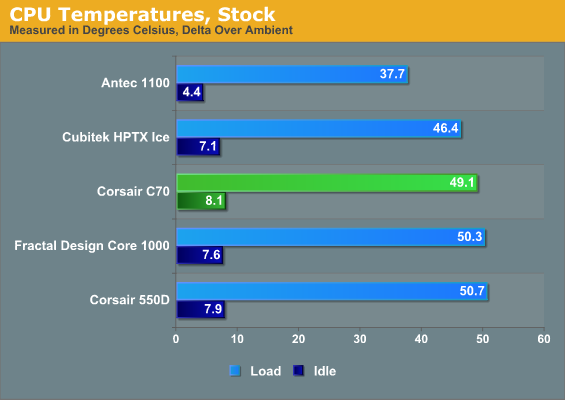
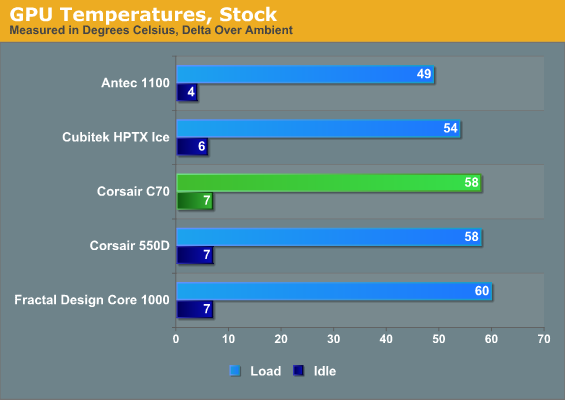
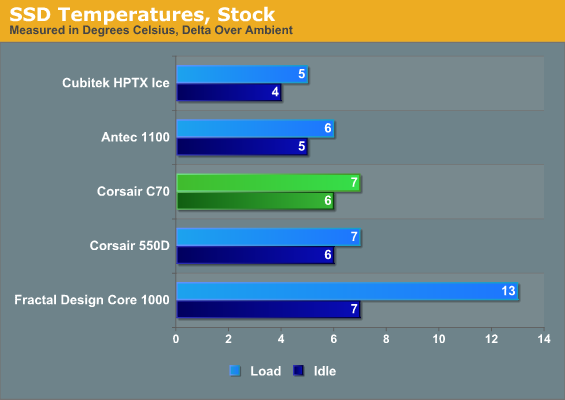
It wasn't that Corsair hadn't made much progress in terms of thermal design, it's that it seems like they haven't made any progress. That's a serious problem, because thermals have historically been the weak point of their designs. Corsair makes easy to build cases, and some of them do have decent thermals, but they've never been stellar and certainly don't excel the way Antec's Eleven Hundred does.
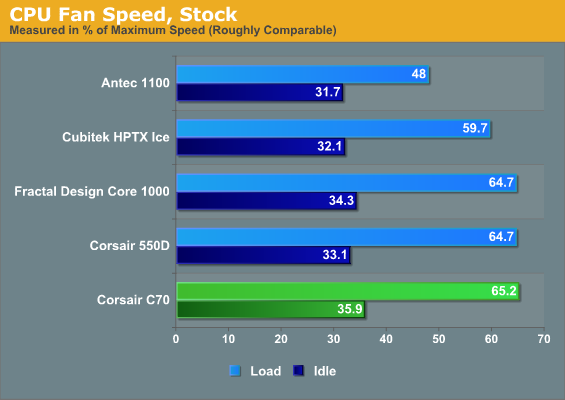
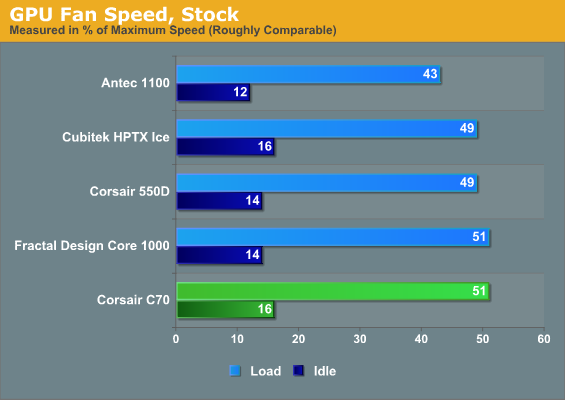
Ambient temperature during testing was about 25.5C which can account for some of the difference, but essentially the C70 is still in line with the Obsidian 550D and Fractal Design's $40 Core 1000. That isn't promising.
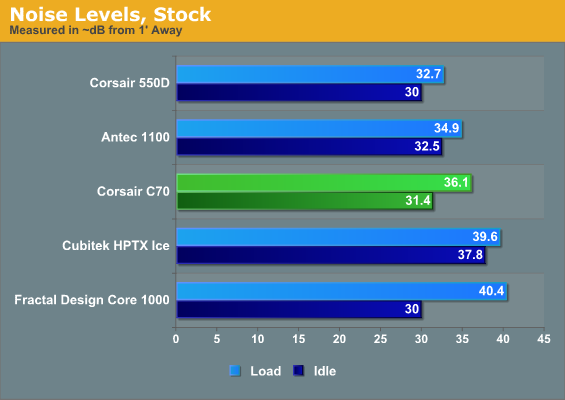
Unfortunately the C70 is also a bit louder under load than the similarly-priced Antec Eleven Hundred, a case that, at least in our stock settings, substantially outperforms it.
Noise and Thermal Testing, Overclocked
Going into overclocked testing after seeing the results from the stock tests didn't leave me with much confidence in the Corsair Vengeance C70. Performance is basically on par with the much quieter Obsidian 550D, while Antec's Eleven Hundred is running away with the crown at as much as $40 cheaper. As you'll see, overclocking didn't treat the C70 much better.
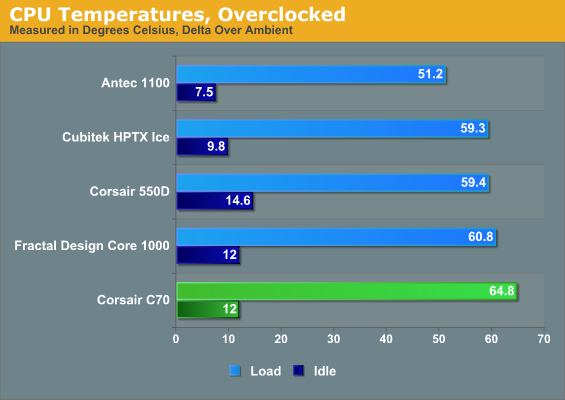
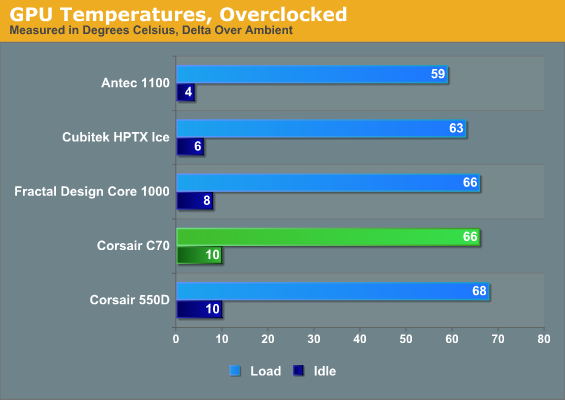
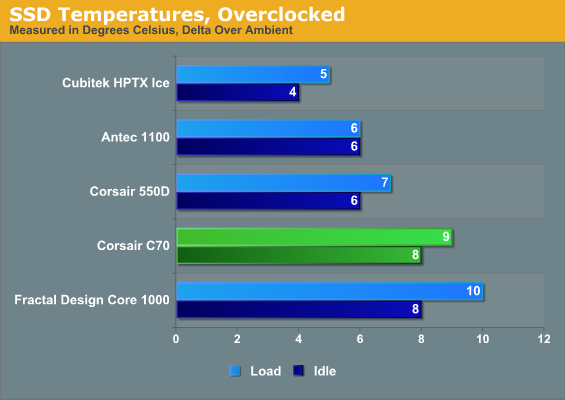
At this point Corsair's own Obsidian 550D is basically running away from the C70 at virtually every metric. I expected at least GPU temperatures to do well with an intake fan sitting right behind the video card, but as a whole the C70 just isn't competitive.
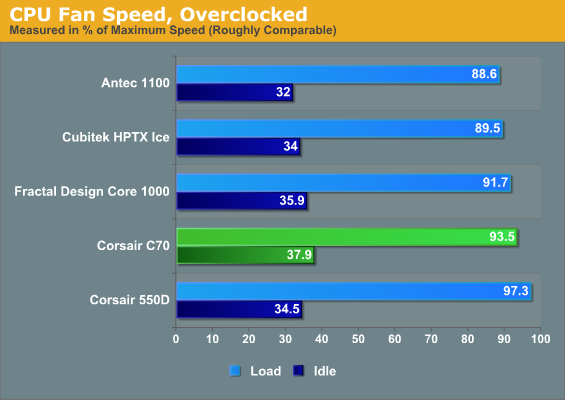
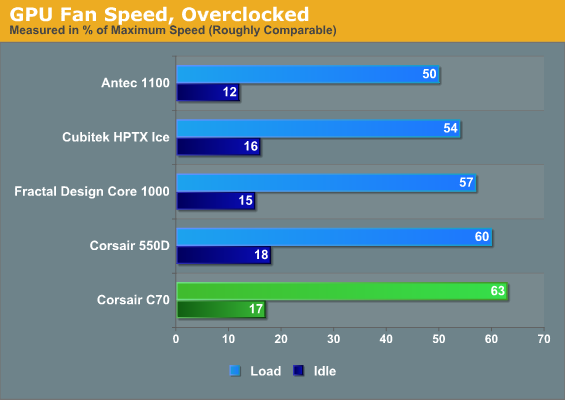
There does seem to be one place where the C70 holds an advantage over the 550D, though: fan speed on the CPU. The 550D has virtually no thermal headroom left on the CPU, while the C70 can probably handle just a little bit more. On the GPU side the situation is flipped, though that could also be chalked up to slightly higher ambient temperatures during testing of the C70.
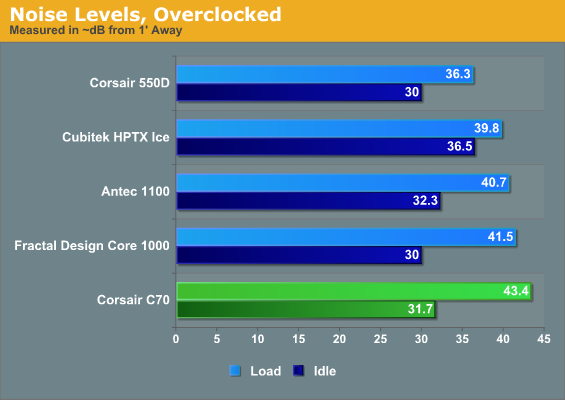
Under load the C70 winds up being the loudest case we've tested, with even Fractal Design's $40 Core 1000 besting it and generally providing a better performance profile overall. Meanwhile the 550D is able to provide comparable (or better) performance at substantially less noise.
Conclusion: Corsair's First Real Misfire
Doing two generally negative case reviews in a row isn't a happy job, and this one is only made worse because frankly, I like Corsair's stuff. I have Corsair RAM in my desktop along with a Corsair SSD, and I'm still using the K90 keyboard. I'm used to being fairly impressed with their kit, but the Corsair Vengeance C70 is a real misstep for their case lineup. Aesthetically it feels off, though that's admittedly a matter of taste, but more importantly the performance is poor.
It's tough to pinpoint exactly where thermal performance went awry for the C70, but I have a couple of theories. The first is that their thermal performance has always been more middle-to-good. That's not necessarily a major problem, at least on the first few cases, because as engineers they're still experimenting and working out the kinks. Internal design has been gradually improved over time, but it's always been incremental. In the C70 that evolution seems to have almost ground to a halt, with only the cage-mounted intake fans being a real change. I also think the amount of ventilation on the C70 may actually be harming performance, as air isn't channeled in a way to maximize performance.
I'm reasonably certain that an end user willing to tinker and test different cooling configurations in the C70 will be able to get better results than I did, but by extension Corsair should've had this figured out before the case even shipped. Whatever the optimal fan configuration might be, I'm pretty sure this isn't it. The fans that come preinstalled are actually fairly quiet at full throttle, but they don't seem to be moving a whole lot of air either. As a result, the case's performance is severely short-changed. Slightly better airflow from the case fans can actually do wonders for reducing thermals and noise, as the fans on the processor and graphics card wind up not having to work anywhere near as hard.
Even with our limited comparison results right now, there's no good reason to go with the C70 over competing offerings. Corsair's own Obsidian 550D costs the same amount of money in retail, is very nearly as customizable, and is much, much quieter. By the same token, Antec's Eleven Hundred costs as much as $40 less than the C70, has some of that enthusiast kick to the external finish, and has substantially better performance at similar or better noise levels. You lose the ability to mount a 240mm radiator in the top of the case, but Antec's similar P280 gives you that option back, and it's still $20 less.
The ultimate problem I have with the C70 is that Corsair is addressing things that were already its strong suits instead of shoring up their weaknesses. Corsair cases were already easy to assemble, and while the increased ease of assembly is welcome, it wasn't the problem. Aesthetically Corsair has always made fairly good-looking cases, so why deviate so wildly from what's been working out fine for them? Meanwhile, the one real weakness of Corsair's cases—thermal performance—is not only left unchecked, but seems to actually be a bit worse.
At the end of it all there's just no reason to buy the Vengeance C70 unless you're married to the look. Antec will outperform it for less money with either the Eleven Hundred or the P280, and even Corsair has better deals with the Carbide 500R and Obsidian 550D. It's easy to build and service, but that's all it really has going for it, and unfortunately that just isn't enough.

_thumb.jpg)
_thumb.jpg)
_thumb.jpg)
_thumb.jpg)
_thumb.jpg)
_thumb.jpg)
_thumb.jpg)
_thumb.jpg)
_thumb.jpg)
_thumb.jpg)
_thumb.jpg)
_thumb.jpg)






